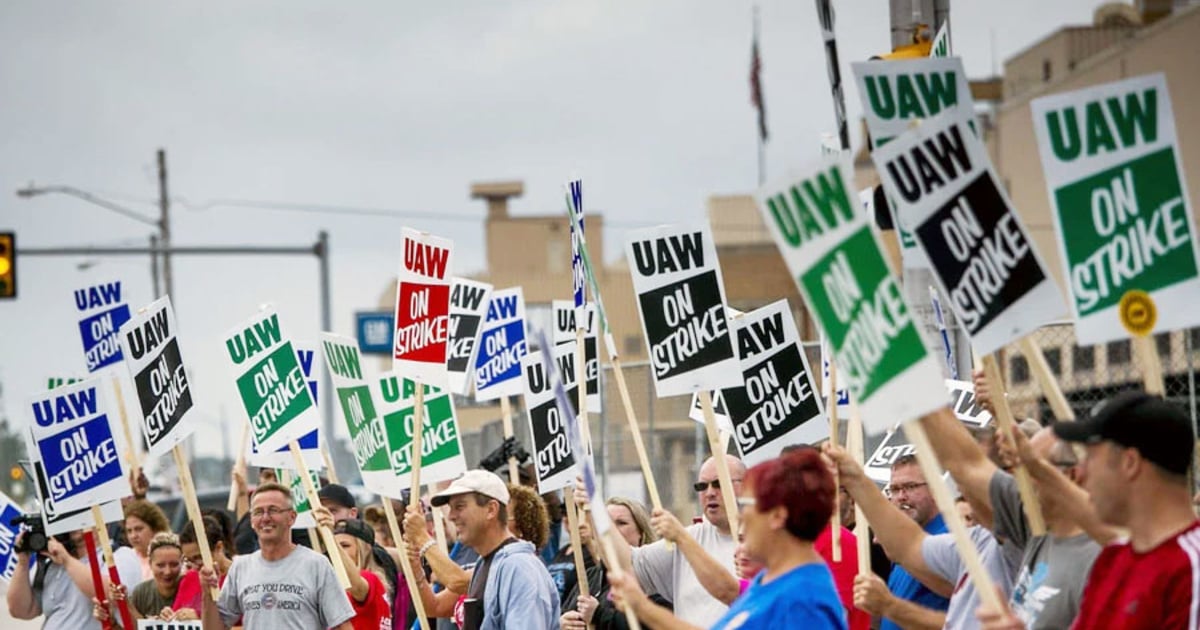
Charges of unfair labor practices, which the UAW filed Thursday against General Motors and Stellantis, are rare in modern Detroit 3 bargaining and mark an escalation of tensions that could shape how a potential strike plays out.
The union submitted the complaints to the National Labor Relations Board, alleging the two companies are “refusing to bargain in good faith over mandatory subjects of bargaining including but not limited to wages and benefits.”
Both GM and Stellantis disputed the charges. The NLRB on Friday said it would investigate.
While such complaints are common, especially against nonunionized automakers, the UAW and Detroit 3 are known to have taken this step against each other only a handful of times.
GM did so in 1998, when UAW members struck two plants in Flint, Mich., ultimately halting production across the company. The grievance and a lawsuit were both withdrawn once the sides reached an agreement to end the strike.
Automotive News found instances when the union filed charges against GM in the early 1960s, against Ford between the late 1930s and early 1940s, and against GM in 1937 as part of the Flint sit-down strike. Labor experts, as well as union and automaker sources, were unaware of other cases.
“What is going on here is extremely untypical,” said a former high-ranking UAW official with deep knowledge of its past legal strategies. “It’s very unusual to go to a third party to seek a resolution.”
The charges, labor experts say, could provide an impetus for the union to strike and would provide workers with more protections if they do.
The National Labor Relations Act differentiates between typical strikes over economic issues — such as the UAW’s 40-day walkout at GM in 2019 — and unfair labor practice strikes protesting an employer’s treatment of workers.
Crucially, workers who strike over an unfair labor practice charge aren’t subject to permanent replacement by their employers, according to the National Labor Relations Act. Companies at times will threaten picketing workers with the loss of their jobs in order to break a strike or push them to accept a deal.
“This is a preemptive strike, before a strike, saying that, if GM and Stellantis had hopes of hiring permanent replacements to starve out the UAW, they can say ‘Sorry, you can’t do that,’ ” said Art Wheaton, a labor expert at Cornell University.
Fain said Thursday on Facebook Live that he filed the charges because the companies had not yet given the UAW counteroffers to the list of demands it announced publicly a month ago.
Although Stellantis had sent a proposal — which Fain publicly bashed — GM is not believed to have done so, although the companies’ current contracts don’t expire until Sept. 14.
The UAW could have a difficult time proving its allegations, experts say, as the companies could argue there’s still time before the deadline and that the union has yet to call for what’s referred to as the companies’ “last, best and final offer.”
Over the next couple of weeks, an investigator will talk with both sides and gather evidence, according to L. Steven Platt, an attorney at Howard & Howard specializing in labor law.
The investigators could tell the parties to simply hash out their differences at the bargaining table before a formal ruling is made, Platt said.
If not, and the labor board rules in the union’s favor, it could seek an injunction and force the parties to negotiate under the presence of a federal monitor. Alternatively, the board could send the case into arbitration or rule against the union and dismiss the charges.
“What’s likely to happen is the board will say, ‘Sit down with each other and negotiate better,’ and if that doesn’t happen, a federal mediator could get involved,” Platt said. “Generally, when you’re negotiating, you don’t want the labor board coming in and telling you what to do.”
Platt said the union filed the charges to gain leverage, although that could fail if the charges are dismissed.
“They had this available as a remedy to them, and they exercised their rights,” he said. “Now it’s up to the labor board investigator and management to respond.”
Lindsay VanHulle contributed to this report.

